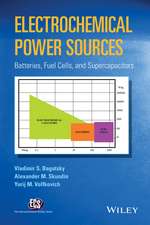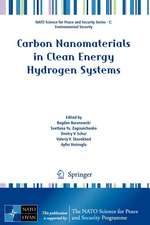External Thermal Insulation Composite Systems (ETICS): An Evaluation of Hygrothermal Behaviour: SpringerBriefs in Applied Sciences and Technology
Autor Eva Barreira, Vasco Peixoto de Freitasen Limba Engleză Paperback – 27 oct 2015
Din seria SpringerBriefs in Applied Sciences and Technology
-
 Preț: 380.29 lei
Preț: 380.29 lei - 17%
 Preț: 360.34 lei
Preț: 360.34 lei - 20%
 Preț: 386.12 lei
Preț: 386.12 lei -
 Preț: 380.07 lei
Preț: 380.07 lei -
 Preț: 377.95 lei
Preț: 377.95 lei -
 Preț: 382.32 lei
Preț: 382.32 lei -
 Preț: 376.59 lei
Preț: 376.59 lei -
 Preț: 379.09 lei
Preț: 379.09 lei -
 Preț: 378.12 lei
Preț: 378.12 lei - 20%
 Preț: 293.83 lei
Preț: 293.83 lei -
 Preț: 344.90 lei
Preț: 344.90 lei -
 Preț: 321.36 lei
Preț: 321.36 lei -
 Preț: 264.79 lei
Preț: 264.79 lei -
 Preț: 344.90 lei
Preț: 344.90 lei -
 Preț: 356.46 lei
Preț: 356.46 lei -
 Preț: 382.95 lei
Preț: 382.95 lei -
 Preț: 355.66 lei
Preț: 355.66 lei -
 Preț: 479.67 lei
Preț: 479.67 lei -
 Preț: 415.18 lei
Preț: 415.18 lei -
 Preț: 444.52 lei
Preț: 444.52 lei - 20%
 Preț: 301.86 lei
Preț: 301.86 lei -
 Preț: 409.43 lei
Preț: 409.43 lei - 20%
 Preț: 322.17 lei
Preț: 322.17 lei -
 Preț: 355.49 lei
Preț: 355.49 lei - 15%
 Preț: 462.51 lei
Preț: 462.51 lei -
 Preț: 377.18 lei
Preț: 377.18 lei -
 Preț: 355.93 lei
Preț: 355.93 lei -
 Preț: 382.95 lei
Preț: 382.95 lei -
 Preț: 378.12 lei
Preț: 378.12 lei -
 Preț: 378.12 lei
Preț: 378.12 lei -
 Preț: 380.07 lei
Preț: 380.07 lei -
 Preț: 380.07 lei
Preț: 380.07 lei - 20%
 Preț: 326.28 lei
Preț: 326.28 lei -
 Preț: 312.68 lei
Preț: 312.68 lei -
 Preț: 356.43 lei
Preț: 356.43 lei -
 Preț: 412.30 lei
Preț: 412.30 lei - 20%
 Preț: 225.31 lei
Preț: 225.31 lei -
 Preț: 378.12 lei
Preț: 378.12 lei -
 Preț: 376.59 lei
Preț: 376.59 lei -
 Preț: 195.87 lei
Preț: 195.87 lei -
 Preț: 376.22 lei
Preț: 376.22 lei - 20%
 Preț: 324.64 lei
Preț: 324.64 lei - 20%
 Preț: 288.73 lei
Preț: 288.73 lei -
 Preț: 377.57 lei
Preț: 377.57 lei -
 Preț: 261.91 lei
Preț: 261.91 lei -
 Preț: 381.98 lei
Preț: 381.98 lei -
 Preț: 273.64 lei
Preț: 273.64 lei -
 Preț: 410.87 lei
Preț: 410.87 lei -
 Preț: 379.68 lei
Preț: 379.68 lei -
 Preț: 374.30 lei
Preț: 374.30 lei
Preț: 376.04 lei
Nou
Puncte Express: 564
Preț estimativ în valută:
71.98€ • 78.21$ • 60.50£
71.98€ • 78.21$ • 60.50£
Carte tipărită la comandă
Livrare economică 21 aprilie-05 mai
Preluare comenzi: 021 569.72.76
Specificații
ISBN-13: 9783319203812
ISBN-10: 3319203819
Pagini: 70
Ilustrații: X, 71 p. 66 illus., 65 illus. in color.
Dimensiuni: 155 x 235 x 7 mm
Greutate: 0.13 kg
Ediția:1st ed. 2016
Editura: Springer International Publishing
Colecția Springer
Seria SpringerBriefs in Applied Sciences and Technology
Locul publicării:Cham, Switzerland
ISBN-10: 3319203819
Pagini: 70
Ilustrații: X, 71 p. 66 illus., 65 illus. in color.
Dimensiuni: 155 x 235 x 7 mm
Greutate: 0.13 kg
Ediția:1st ed. 2016
Editura: Springer International Publishing
Colecția Springer
Seria SpringerBriefs in Applied Sciences and Technology
Locul publicării:Cham, Switzerland
Public țintă
ResearchCuprins
Introduction.- External Thermal Insulation Composite Systems (ETICS).- Hygrothermal behaviour of ETICS – Experimental and numerical study.- Critical parameters involved in exterior surface condensation on ETICS.- Risk assessment of hygrothermal behaviour of ETICS.- The effect of nearby obstacles in surface condensations on ETICS – Experimental and numerical study.- Conclusions.
Notă biografică
Eva Barreira is an Assistant Professor at University of Porto – Faculty of Engineering (FEUP). Collaborator of the Building Physics Laboratory. Member of CIB W040 – Heat and Moisture Transfer in Buildings. Author of about 50 scientific publications on Hygrothermal Behaviour, Building Physics, Building Rehabilitation and Building Pathology.
Vasco Peixoto de Freitas is a Full Professor at University of Porto – Faculty of Engineering (FEUP). Director of the Building Physics Laboratory and Building Rehabilitation Advanced Course at FEUP. Coordinator of CIB W040 – Heat and Moisture Transfer in Buildings and CIB W086 – Building Pathology. Author of more than 400 scientific publications on Building Rehabilitation, Building Pathology, Hygrothermal Behaviour and Building Physics.
Vasco Peixoto de Freitas is a Full Professor at University of Porto – Faculty of Engineering (FEUP). Director of the Building Physics Laboratory and Building Rehabilitation Advanced Course at FEUP. Coordinator of CIB W040 – Heat and Moisture Transfer in Buildings and CIB W086 – Building Pathology. Author of more than 400 scientific publications on Building Rehabilitation, Building Pathology, Hygrothermal Behaviour and Building Physics.
Caracteristici
Explores a little-investigated topic: the hygrothermal behaviour of external thermal insulation composite systems (ETICS) Presents a methodology to estimate the risk of surface humidification, which can then be used as a decision support tool Introduces new validated routine to simulate factors affecting the exterior surface temperature of walls at night Includes supplementary material: sn.pub/extras


















